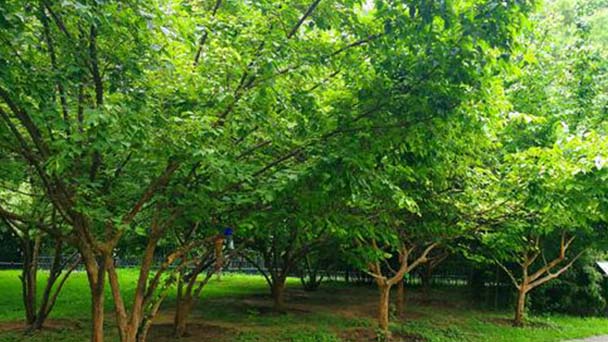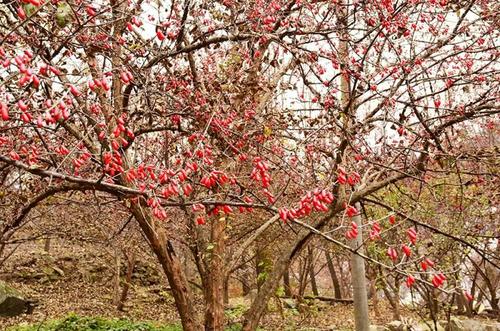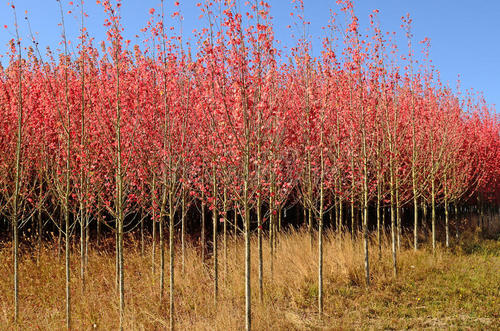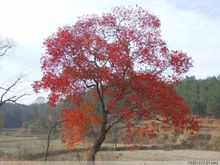Asiatic dogwood profile
Written by Maggie
Feb 07 2021

Asiatic dogwood, scientific name Cornus officinalis, is a deciduous shrub or small tree, 4-10 m tall; Asiatic dogwood bark grayish is brown; Branchlets are finely cylindrical, glabrous or sparsely appressed pubescent. Winter buds are terminal and axillary, ovate to lanceolate, covered with yellowish-brown pubescent. Flowers are yellow, drupes oblong, 1.2-1.7 cm long, 5-7 mm in diameter, red to purplish red; Caryophyte is narrow elliptic, about 12 mm long, with a few irregular ribs.
Asiatic dogwood picture

Asiatic dogwood distribution
Asiatic dogwood (Cornus officinalis) is distributed in temperate regions of the Northern Hemisphere, NW South America, Africa, South Asia, Southeast Asia to Oceania.
Morphological characteristics of Asiatic Dogwood
Branch
Asiatic dogwood (Cornus officinalis) is deciduous tree or shrub, 4-10 meters high; Bark is grayish brown; Branchlets are finely cylindrical, glabrous or sparsely appressed pubescent. Winter buds of asiatic dogwood are terminal and axillary, ovate to lanceolate, covered with yellowish-brown pubescent.
Leaf
Asiatic dogwood (Cornus officinalis) leaves are opposite, papery, lanceolate or elliptic oval shape oval, 5.5-10 cm long, 2.5 4.5 cm wide, apex abruptly acuminate, base broadly cuneate or nearly circular, margin entire, the green, glabrous, beneath the pale green, thin pasted by white pubescent, vein axils densely light brown fur, midrib above clearly, raised below, nearly glabrous, lateral veins 6 or 7 pairs, curved inside bow; Petiole of Asiatic dogwood is slender cylindrical, 0.6-1.2 cm long, shallow furrows above, rounded below, slightly appressed pubescent.
Flowers
Asiatic dogwood (Cornus officinalis) is an umbellate inflorescence on the side of branches, with involucre 4, ovate, thick papery to leathery, about 8 mm long, purplish, slightly pubescent on both sides, falling off after flowering; Pedicels of Asiatic dogwood are stout, ca. 2 mm long, lightly gray pubescent; Flowers are small, bisexual, first leaves open; Asiatic dogwood has 4 calyx lobes, broadly triangular, as long as or slightly longer than disk, ca. 0.6 mm, glabrous; Asiatic dogwood has 4 petals, ligule-lanceolate, 3.3 mm long, yellow, reflexed; Asiatic dogwood has 4 stamens, alternate with petals, 1.8 mm long, filaments subulate, anthers elliptic, 2-loculed; Disk is cushion-shaped, glabrous; Ovary is inferior, rectum obovate, ca. 1 mm, densely appressed sparsely pubescent, style cylindrical, 1.5 mm long, stigma truncate; Pedicels of Asiatic dogwood are slender, 0.5-1 cm long, densely pubescent.
The flowering period of Asiatic Dogwood is in spring.
Fruit
The drupes of Asiatic Dogwood (Cornus officinalis) are oblong, 1.2-1.7 cm long, 5-7 mm in diameter, red to purplish red; Caryophyte, narrowly elliptic, ca. 12 mm long, with a few irregular ribs.
The fruiting stage of Asiatic Dogwood (Cornus officinalis) is in autumn.
Ecological habits of Asiatic dogwood
Asiatic dogwood (Cornus officinalis) is a warm temperate positive tree species, the suitable temperature for growth is 20~30℃, and the growth is poor if the temperature exceeds 35℃. The Asiatic Dogwood is more tolerant to shade but likes sufficient light. It usually grows well in the middle and lower part of the hillside, the shady slope, the sunny slope, the valley and the banks of the river. It is generally distributed in the area of 400~1800m above sea level, of which 600~1300m is more suitable. Asiatic Dogwood should be planted in well-drained, rich in organic matter, fertile sandy loam soil. The clay should be mixed with a proper amount of river sand to increase drainage and air permeability.
Asiatic dogwood propagation methods
Seeds
Cultivate ground choice: Cultivate seedling ground need to choose fertile and deep, the terrain is relatively flat. Whole, loose soil, leeward to the sun, there are water pouring conditions, to ensure that water can be irrigated at any time. Before sowing Asiatic dogwood, the seedling ground must be deep ploughing fine rake, leveling, leveling, ensure loose, fine, level off, no roots, no stone tiles, ploughing depth in more than 20 cm, it is important to combine deep ploughing into the retting system of good farm manure.
Seed preparation: ⑴ Seed picking: choose healthy growth, in the prime period of fruit, no good mother trees. Pick the ripe fruit of Asiatic dogwood (Cornus officinalis) in autumn, full and large, free from pests and diseases, without damage, and dark red color. Remove the flesh from the picked fruit. ⑵ Seed treatment: the Asiatic dogwood seed treatment is directly related to the emergence rate, is very key. First, put the seeds in 5% alkaline water, rub 5 meters by hand, then add boiling water, stir while pouring boiling water, until the seeds are immersed in the boiling water.After soaking in cold water for 24 hours, remove the seeds and put them in the concrete for 8 hours. Repeat this for at least 3 days. When 90% of the shells have cracks, mix them with wet sand and seeds in a 4:1 ratio and then store them in the sand. Often spray water to keep wet, check frequently, in case of seed occurrence mildew rotten, the 2nd year spring opens pit to take seed can sow. This treatment is suitable for spring sowing. If you choose autumn sowing, you only need to soak the seeds in warm water of not less than 70℃ for 3 days to sow (pay attention to change the hot water in time after the water is cool), and then cover the seeds with film to accelerate germination.
Sowing: spring sowing seedlings of Asiatic dogwood (Cornus officinalis) before and after the vernal equinox, the first year of autumn sand seeds dug out sowing, sowing in the beds according to 30 cm row distance, open a shallow trench about 5 cm deep, the seeds evenly spread in the trench, covered with soil 3-4 cm, keep the soil moist, 40-50 days can be seedlings. Seed amount 90-150 kg/hour square meters.
Layering
After the autumn fruit of Asiatic dogwood (Cornus officinalis) harvest or the earth thaw bud germination, nearly two or three years of the ground branches bent to the ground, near the ground will be cut to the xylem 1/3 branches buried in the soil has applied heat manure, covered with 15 centimeters of sandy loam, branch tip exposed to the ground. Watering, the second year of winter or the third year of spring will have long roots of the lamination cut off and mother plant join part, will have root seedling and other land planting.
Cuttings
In spring, cut branches from the excellent mother plants of Asiatic dogwood (Cornus officinalis), cut the lignified branches into 15-20cm sticks, keep 2-4 leaves on the upper branches, insert into the seedbed made by mixing humus soil and fine sand, plant spacing of 20cm × 8cm, depth of 12-16cm, covered with soil of 12-16cm, compacted. Pour enough water, cover the agricultural film, keep the temperature 26-30℃, relative humidity 60%-80%, put up shade shade on the top, transmittance 25%, in the summer transmittance to 10% to avoid strong light irradiation. Overwintering before the removal of the shade shed, pouring enough water. The next year appropriate soil and grass, strengthen water and fertilizer management, late autumn and early winter or the next early spring seedlings planting.
Grafting
It is difficult to breed Asiatic Dogwood (Cornus officinalis) seedlings. The seedlings can bear fruit for more than 10 years after colonization, and the grafted seedlings can blossom and bear fruit in 2-3 years. Seedling grafting can make Asiatic Dogwood bear early and gain early.
Rootstock selection: Rootstock should use their own fine seed seedlings.
Scion: Scion should be selected from high yield, robust growth, free of pests and diseases of high quality mother trees. When collecting scions, full-grown annual branches with full buds should be collected from the periphery of the tree crown.
Grafting time: Early spring rootstock begins to germinate.When the scion bud just sprouted (mid to late March or so) with grafting skin;

Asiatic dogwood growing method
After insert management
Cuttings immediately after irrigation, make cuttings of Asiatic dogwood (Cornus officinalis) and soil close contact, so that cuttings can absorb enough water, and then cover agricultural film, temperature should be maintained at 26-30℃, relative humidity 60%-80%, the upper shade shed, transmittance 25%, in the middle of summer should avoid strong light irradiation. Overwintering before the removal of the shade shed, pouring enough water. The next year appropriate soil and grass, strengthening water and fertilizer management, late autumn and early winter or the next early spring seedlings planting.
Seedling stage management
Seedlings grow 2 pieces of true leaves for thin, seedling distance of 7 cm, weed removal, in early summer ploughing, before winter watering 1 times, and to the seedling root soil, in order to ensure safety over winter.
Because the seed coat of Asiatic Dogwood (Cornus officinalis) is hard and not easy to germinate, whether it is spring or autumn sowing, after sowing, it should be covered with plastic film in time to keep heat and moisture. Under normal circumstances, seedlings can be full in 1 year. After the seedlings of Asiatic dogwood (Cornus officinalis) to strengthen management, timely loosening soil weeding, depending on soil moisture watering, fertilization to promote seedling growth, cultivation to seedling height 80-100 cm, can be out of the nursery planting.
Field management
After transplanting Asiatic dogwood (Cornus officinalis), plow and weed 4-5 times a year; The application of superphosphate in summer could promote the differentiation of flower buds and increase the fruit-setting rate, and the application of wax fertilizer in winter could also balance the difference between young and large ears. Plant soil once in summer to prevent lodging. When sapling height is about 40-60 cm, hit the top tip in February, choose to leave 3-4 main branches, and then choose to leave 3-4 secondary main branches on the in-service main branches, forming a natural open heart. Young Asiatic dogwood trees to plastic - based, pruning auxiliary. And because Asiatic Dogwood (Cornus officinalis) long, medium and short fruit branches are mainly the top flower bud results, all kinds of fruit branches should not be short. Adult Asiatic dogwood trees are pruned in spring and fall to adjust the conflict between growth and fruit, renew the group of fruiting branches, retain the growing branches, truncate and promote branching.
The main value of Asiatic dogwood
The Asiatic dogwood (Cornus officinalis) contains 16 kinds of amino acids. In addition, it contains a large number of essential elements for the human body.In addition, it contains saponins, polysaccharides, malic acid, tartaric acid, phenols, resins, tannins and vitamins A, C and other components with strong physiological activity. Asiatic dogwood sour and astringent taste, with nourishing, stomach, diuretic, liver and kidney, Qi and blood and other effects. The main treatment is high blood pressure, waist and knee pain, vertigo, tinnitus, impotence, menorrhagia and other diseases.
The mature and dry fruit of Asiatic Dogwood (Cornus officinalis), which is the precious medicinal material of sweet potato meat after the kernel is removed. Fruit medicine, for astringent blood tonic and strong agent; Asiatic dogwood can strengthen stomach, nourish liver and kidney, treat anemia, lumbago, nerve and heart weakness. Its sexual taste sour and astringent, enter liver, kidney meridian. Sour and astringent, it has the function of nourishing liver and kidney, solidifying kidney and astringent essence. Asiatic dogwood (Cornus officinalis) is suitable for waist and knee sore and soft caused by liver and kidney deficiency, spermatorrhea, vertigo and tinnitus.
The Asiatic dogwood (Cornus officinalis) is rich in nutrients and functional components. Li Shizhen's "Compendium of Materia Medica" in the Ming Dynasty collects the experience of the application of Asiatic Dogwood (Cornus officinalis) by physicians in all dynasties, and lists Asiatic Dogwood as a medicine to tonify blood and consolidate essence, tonify liver and kidney, regulate qi, tonify deficiency, improve eyesight and strengthen the body.
Economic
The development of green health food with Asiatic Dogwood (Cornus officinalis) as raw material can be processed into drinks, jams, candies and other foods.
Watch
Asiatic Dogwood (Cornus officinalis) first flowers after the bud leaves, autumn red fruits, crimson to drop, gorgeous and pleasing to the eye, for autumn and winter fruit, applied to landscaping is very popular, can be in the garden, flower beds single plant or piece plant, landscape effect is very beautiful. Potted plants can last up to three months and are popular in flower markets.

Latest Updated
- Benefits of Bugleweed - 7 Science-backed Health Benefits
- Bugleweed Dangers & Side Effects - Is It Poisonous?
- How to Plant Evergreen Trees - What You Should Know
- When to Plant Evergreens - Grow Guide for Evergreen Trees
- 12 Wonderful Evergreen Shrubs for Your Garden
- 12 Popular Evergreen Plants with Pictures for Beginners
- When And How To Prune A Lilac Bush Like a Pro
- How to Grow & Care for Lilac Vine (Hardenbergia Violacea)
- Japanese Lilac Tree (Syringa Reticulata) Care & Propagation Guide
- Shumard Oak Pros and Cons - What to Know
Popular Articles
- Winter maintenance of Antirrhinum Majus
- How to Grow Terminalia Mantaly Tree
- How to Grow and Care for Crossostephium Chinense
- How to grow Antirrhinum Majus in spring
- Peristeria Elata (Dove Orchid) Profile: Info & Care Guide
- Underwatered Snake Plant (Sansevieria Trifasciata) - Signs And How To Fix
- How to Care for Brazilian Jasmine Plant (Mandevilla Sanderi)
- How to Grow & Care for Graptopetalum Purple Delight in Summer
- Rosa Chinensis (China Rose): Plant Growing & Care Tips
- How to Care for Baby Sun Rose (Aptenia Cordifolia)